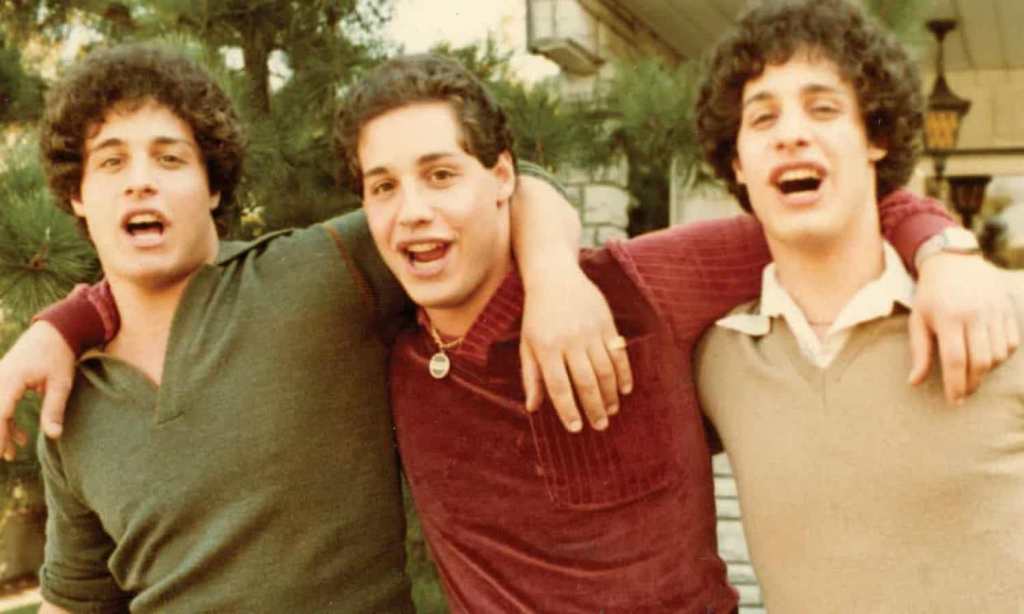This article contains spoilers for Three Identical Strangers story as it follows real-life events.
It was one of the most high profile reunions in history. Their faces were splashed across newspapers around the world, and the press couldn’t get enough of Robert Shafran, Edward Galland and David Kellman — triplets who were separated at birth.
While at first, Netflix’s newest documentary offering, Three Identical Strangers (2018) seems like a heartwarming story of family reunion, the true story is cruel. Shafran, Galland and Kellman were separated at birth and placed in different families — one blue-collar, one middle-class and the third, the home of an affluent doctor.
In 1980, when the triplets were 19-years-old, a chance encounter and a case of mis-identity, caused the brothers to discover one another. Up until then, neither they nor the families knew that either one had existed.
At first, the story of the handsome, smiling triplets was lapped up by the media, despite their different upbringings, the three men were the same. They walked the same, they danced the same, they smoked the same type of cigarettes and each even had an affection for older women. Their adoptive parents even revealed that as babies, each child would become distressed, banging their head against the side of their crib.
They were an overnight sensation — the triplets even scoring a cameo in the Madonna movie Desperately Seeking Susan. For fifteen years, the men lived a happy existence — opening a restaurant together named Triplets and each finding love and having children.
But fractures and fissures began to surface. All three men suffered from mental health issues and in 1995, Galland took his own life after a struggle with depression.
Later, Kellman would tell the New York Post: “It was absolutely separation anxiety. Those who were studying us saw there was a problem happening.
“And they could have helped. That’s the thing we’re most angry about. They could have helped . . . and didn’t.”
That same year, 1995, a New Yorker journalist Lawrence Wright was conducting research for a piece called Double Mystery. In his story, Wright wrote about Dr Peter Neubauer and his ‘nature versus nurture’ project which began in the 1950s.
Through his findings, Wright soon discovered that Neubauer had worked with an elite adoption agency, The Louise Wise Agency, to monitor identical siblings through childhood. The only catch? The children had to be separated.
In the documentary, the brothers recalled having people from the agency film them, asking them to say this and that, ride a bike or paint a picture, under the guise that they were monitoring children who had been adopted out.
However, shortly after the men had been reunited, their parents cottoned on to the experiment and confronted the evasive personnel at the adoption agency. Furious at what they and their children and been put through, they received no answers until a chance encounter, propelled them to find out the truth. Their children had been separated deliberately, along with many others.
Psychologists had partnered with the agency for the “Twin Study” and even Neubauer visited the boys for the first 10 years.
The secret research project was never published and it was never known who the “private Washington charities” were that bankrolled it. The other chilling find? No one, except those who participated, knows how many sets of siblings were separated.
In an interview with the New York Post, Shafran said that he couldn’t “think of anybody else in modern times that has done anything like this.”
“The other comparisons I can think of would be the Tuskegee syphilis experiment, where they let them all get syphilis and let it go untreated, and they died horrible deaths.”
Three Identical Strangers filmmaker Tim Wardle said that you didn’t have to be a scientist to figure out why these men had issues.
“One of the most shocking these was that these psychiatrists are sitting around saying, ‘Oh, it’s really strange, the children all seem to have these problems.
“The answer is obvious – you’ve ripped them apart from their siblings.”
Stream Three Identical Strangers on Netflix now.
If you or someone you know needs help, please contact BeyondBlue on 1300 224 636 or Lifeline on 13 11 14.
Read more stories from TheLatch— and follow us on Facebook.

